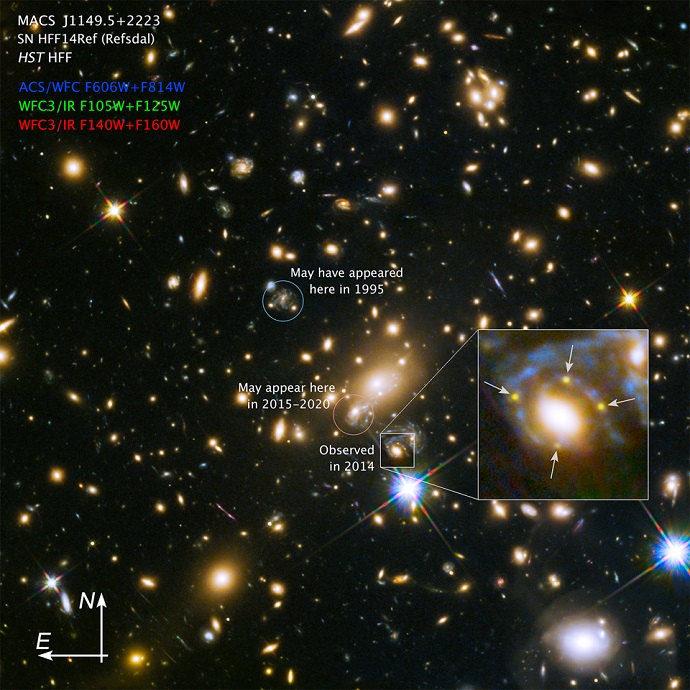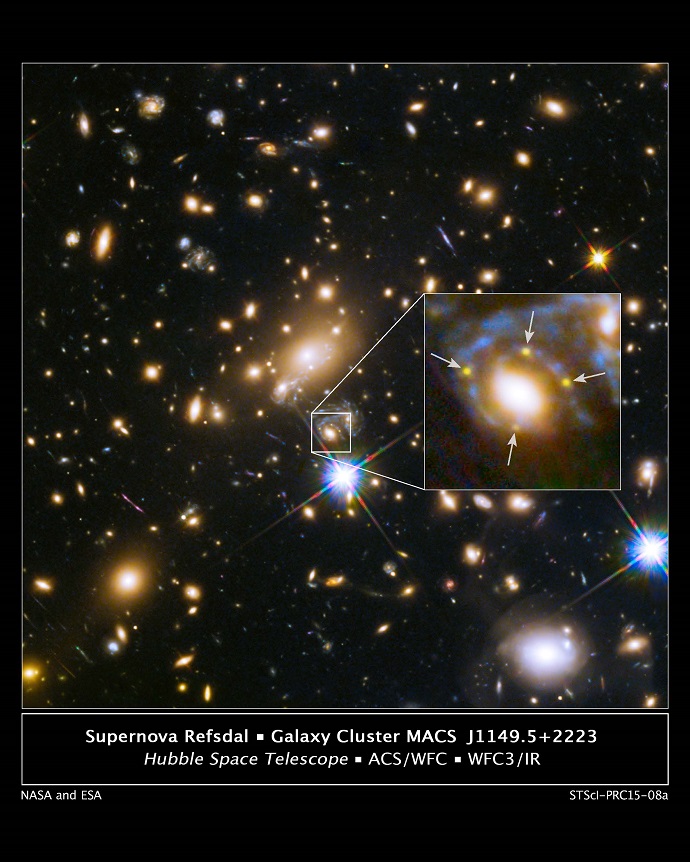March 05, 2015
Using multiple images that reached the Earth at different times, astronomers including a UCLA professor have reported the first discovery of a distant star exploding into a supernova. A supernova, the end stage of life for very massive stars, can briefly outshine an entire galaxy and radiate as much energy as our sun emits in its entire lifespan.
The research is published today in a special issue of the journal Science celebrating the centennial of Albert Einstein’s Theory of General Relativity.
In pictures transmitted by NASA’s Hubble Space Telescope, the astronomers spotted four images of a supernova arranged in the shape of a cross, known as an “Einstein’s Cross.” The shape was created by the powerful gravity of a foreground galaxy embedded in a massive cluster of galaxies.
The galaxy cluster is so large that its gravity bends and intensifies the light from the supernova, which resides roughly 4 billion light-years behind it, through an effect called gravitational lensing. First predicted by Einstein, the effect is similar to that of a glass lens bending light to distort the image of an object behind it.
The finding will help astronomers refine their estimates of the amount and distribution of dark matter in the lensing galaxy and cluster. Although it cannot be seen directly, dark matter is believed to make up the majority of the universe’s mass.
Astronomers may have a rare chance to see the supernova again within the next five years, according to computer models of the cluster that describe the various paths the divided light is taking through the maze of clumpy dark matter in the galactic grouping.

Supernova appears multiple times
The powerful gravity of a massive cluster of galaxies in this Hubble Space Telescope image produces multiple images of the same distant supernova behind it. The cluster is acting like a giant “cosmic lens,” bending and magnifying light from the exploding star in an effect called gravitational lensing.
This image combines data from three months’ worth of observations taken in visible light by the Advanced Camera for Surveys and in near-infrared light by the Wide Field Camera 3.
NASA, ESA, and S. Rodney (JHU) and the FrontierSN team; T. Treu (UCLA), P. Kelly (UC Berkeley) and the GLASS team; J. Lotz (STScI) and the Frontier Fields Team; M. Postman (STScI) and the CLASH team; and Z. Levay (STScI)
The four supernova images captured by Hubble appeared within a few days or weeks of one another. That’s due in part to differences in the length of the pathways the light follows to reach Earth — each image takes a different route through the cluster before it heads toward our planet.
“The supernova’s different light paths are like different routes through Los Angeles traffic,” said Tommaso Treu, a professor of physics and astronomy in the UCLA College, a co-author of the research and principal investigator of the Grism Lens Amplified Survey from Space project, or GLASS, that is analyzing the supernova. “One light path takes the freeway, and others take surface roads. The freeway itinerary is longer but the speed is higher.”
► Animation: How a massive galaxy cluster’s gravity bends and focuses the light from a supernova
If the cluster were not present, astronomers would detect only the supernova light that is directed straight at Earth and would see only a single image of the supernova.
Treu said that by studying the delays between the times that the different images reach Earth, astronomers can glean clues about the type of warped-space terrain the supernova’s light had to cover.
“With this discovery, we can learn something new about dark matter. The brightness and delays of future images could tell us something about the clumpiness of dark matter,” he said, adding that standard cosmological models predict that dark matter is predicted to be clumpy. “But this is very hard to measure directly because we cannot see it. This is a rare opportunity to get a glimpse of the mysterious dark matter.”
Patrick Kelly, a postdoctoral researcher at UC Berkeley and a member of the GLASS collaboration, first discovered the four images of the exploding star in November 2014 in the images of a galaxy cluster known as MACS J1149.6+2223, which is located more than 5 billion light-years away.
The GLASS team and a second group of researchers known as the Frontier Fields team, led by Steve Rodney of Johns Hopkins University, spent a week analyzing the object’s light and confirmed it was the signature of a supernova. They then turned to the W. M. Keck Observatory on Mauna Kea, Hawaii, to measure the distance to the supernova’s host galaxy, which is 9.3 billion light-years from Earth.
The astronomers nicknamed the supernova Refsdal in honor of Norwegian astronomer Sjur Refsdal, who, in 1964 first proposed using time-delayed images from a lensed supernova to study the expansion of the universe.
“Astronomers have been looking to find one ever since,” Treu said. “Now the long wait is over.”
UCLA co-authors of the research were Alessandro Sonnenfeld, a postdoctoral scholar in Treu’s research group, and Matthew Malkan, a professor of physics and astronomy.















